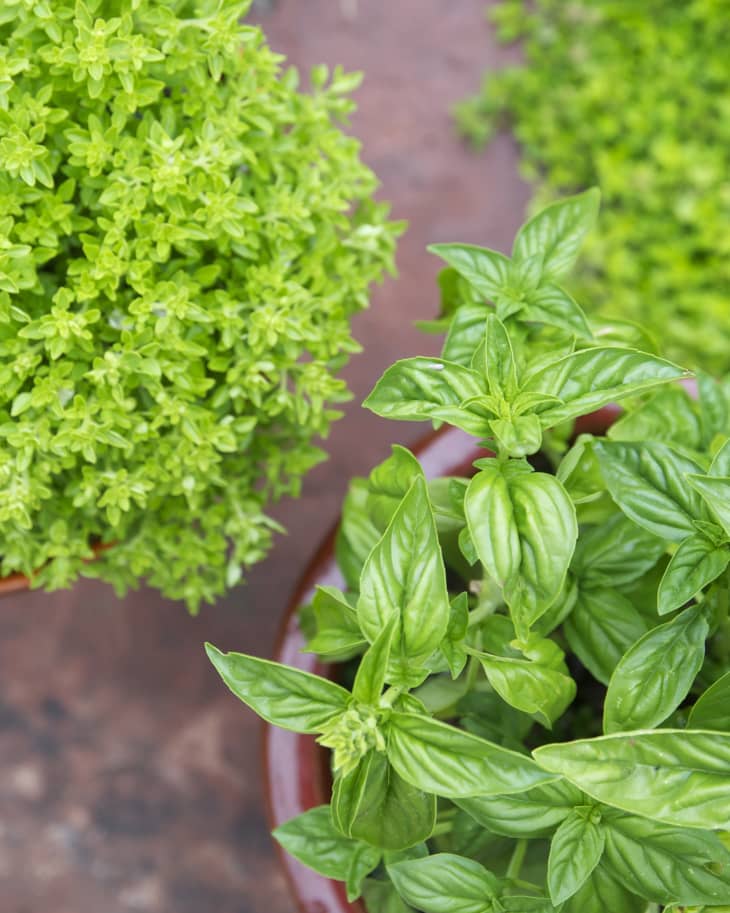How to Grow Basil in a Container Herb Garden
Basil is the most perfect herb — especially when summer rolls around. I generously sprinkle it over caprese salads, top pasta with it, muddle it into Bloody Marys, and make sweet basil syrup for my sliced summer strawberries. And don’t even get me started about how liberally I toss freshly chopped basil on my pizza; I know I’m not alone here.
But those packages or bundles of basil at the grocery store can really add up. To grow your own basil, simply find a sunny windowsill, fill a container with well-drained soil, and plant it among other herbs and vegetables. Fun fact: It’s way less expensive to buy an established basil plant and focus your energy on growing your own leaves. Plus, it doesn’t get much fresher than basil you freshly picked two seconds ago!
Here’s everything you need to know about growing your own basil.
Why Should I Grow Basil?
There’s nothing like clipping fresh basil leaves from your garden (or windowsill!) and adding it right into whatever you’re cooking. The question should really be: “Why shouldn’t I grow basil?” Basil’s fresh, spicy, clove-scented flavor profile is a natural addition to so many cooking styles and cuisines.
Just one well-pruned plant will supply you with about a 1/2 cup’s worth of basil each week. Even if you’re limited on space, simply find a sunny windowsill, fill a container with well-drained soil, and you’re in business. Basil for months.
Certainly the most common cultivar of basil is sweet basil or Genovese basil, but other culinary options — such as Thai, lemon, globe, and cinnamon — are also readily available. One of the main differences between basil and other herbs is the fact that it is a tender annual. It is very sensitive to the cold, so get ready to plant it soon! May is the best time to start growing basil!
How to Plant Basil
- Where: Basil is a wonderful addition to a container garden. It thrives in well-drained soil, positioned in a sunny window. In a larger garden, plant basil among your tomatoes. It’s a one-stop shop for your next caprese salad.
- When: Basil is easy to sow from seed and is relatively quick to germinate. When planting from seed, plant seeds about six weeks before the last frost. Basil is super sensitive to the cold, so whether you are transplanting seedlings from indoors or have plants in the ground, watch the early spring temperatures and cover if necessary. If you are planting a cutting or transplanting a seedling or smaller plant, make sure the ground temperature is at least 70°F.
- Propagation: In addition to sowing basil from seed, a cutting of basil will easily root when placed in water. Select a four-inch section of basil that has not yet flowered. Roots will form within a week. Transplant the basil directly into the garden or container once a healthy root system is apparent.
How to Cultivate Basil
- Soil: Basil does its best in well-drained, moist soil with a neutral pH. I add a rich compost to the soil at the beginning of the season. Not much more soil amendment is necessary. In fact, if the soil is too rich, basil loses some of its flavor intensity.
- Sun: Basil grows well in warm environments that receive about six hours of sun each day. I have a couple of basil plants growing in an area that receives only four hours of sun, but they aren’t as prolific as the others. My best basil plants actually grow in an east-facing area that doesn’t get the scorching, midday sun.
- Water: Give basil water when the soil is dry to the touch, doing your best to water the plant at its base and not all over its leaves.
- Spacing: Depending upon the variety, basil grows anywhere from 12 to 24 inches in height. Space basil plants 12 to 16 inches apart. If you’re limited on space or only grow in containers, consider spicy globe basil, which tends to form a small, mounding habit.
- Companion planting: Plant basil among other herbs and vegetables with similar lighting and watering needs, like tomatoes or parsley. Some even say tomatoes taste better when they neighbor basil. Plant basil alongside chamomile, lettuce, peppers, and oregano. I even like to keep a few pots of basil on my back porch to deter mosquitoes.
How to Harvest Basil
Basil is a pick-as-you-go kind of herb. You may harvest only what you need, or if you have an abundance on hand, you may clip a mass harvest. Harvest basil as you would mint, snipping a stem just above the point where two large leaves meet. Regular clipping encourages a more rounded, less leggy plant.
It’s always better to harvest basil before the plant flowers. If you don’t have time to harvest any leaves, just pinch off the flowering portion. The flowers are actually edible, but if you pinch them off, the plant can now direct its energy on growing tasty leaves. Also be sure to only harvest up to 2/3 of the entire plant, so it can continue producing.
